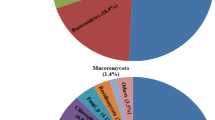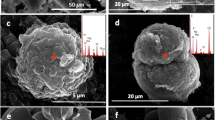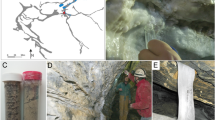Abstract
DON JUAN POND, which contains saturated calcium chloride brine, is in the south fork of the dry Wright Valley of Antarctica at latitude 77°33′S and longitude 167°10′E, and has been controversial almost since its discovery in 1961. Meyer et al.1,2 reported a sparse microflora of four species of heterotrophic bacteria and a yeast. Cameron, Horowitz and colleagues3,4, using the Antarctic dry valleys as the best available natural simulation of Mars, reported that many areas were virtually sterile and, at most, limited to sparse bacterial populations. Field work5–10 has revealed a more abundant and varied microflora of yeasts, blue-green algae, fungi and bacteria, especially in the bottoms of frozen freshwater lakes. However, reports point to an extreme dry valley–exposed rock South-Polar biome consisting predominantly of heterotrophic forms, mainly prokaryotic with occasional fungal associates. If this is correct Don Juan Pond must, like the dry valleys generally, consist only of converter–consumer populations lacking extensive capability for continuous carbon reduction. Cameron has emphasised the ecological restrictions on the activity and distribution of algae in the dry valleys and mentions no algal or other autotrophic forms in his discussion of Don Juan Pond, even though thin organic layers were found 2 m below the 15–20 cm of standing water11. However, in the course of a mercury sampling programme during the austral summer of 1978–79 we observed an extensive, irregular pellicle or mat-like structure 2–5 mm thick but extending 500–600 m2 over much of the western part of the Don Juan Pond salt flats.
This is a preview of subscription content, access via your institution
Access options
Subscribe to this journal
Receive 51 print issues and online access
$199.00 per year
only $3.90 per issue
Buy this article
- Purchase on Springer Link
- Instant access to full article PDF
Prices may be subject to local taxes which are calculated during checkout
Similar content being viewed by others
References
Meyer, G. H. Polar Rec. 11, 317 (1962).
Meyer, G. H., Morrow, B., Wyss, O., Berg, T. E. & Littlepage, J. L. Science 138, 110 (1962).
Cameron, R. E., Honour, R. C. & Morelli, F. A. in Extreme Environments Mechanisms of Microbial Adaptation (ed. Heinrich, M. R.), 57 (Academic, New York, 1976).
Horowitz, N. H., Cameron, R. E. & Hubbard, J. S. Science 176, 242 (1972).
Friedmann, E. I. Antarctic J. 12, 26 (1977).
Friedmann, E. I. & Ocampo, R. Science 193, 1247 (1976).
Holm-Hansen, O. Phycologia 4, 42 (1964).
Vishniac, W. V. & Mainzer, S. E. Antarctic J. 7, 88 (1972).
Drouet, F., Polar Rec. 11, 320 (1962).
Uydess, I. L. & Vishniac, W. V. in Extreme Environments, Mechanisms of Microbial Adaptations (ed. Heinrich, M. R.), 29 (Academic, New York, 1976).
Mudrey, M. G. Jr, Torii, T. & Harris, H. Dry Valley Drilling Project (DVDP) Bulletin, 85 (August, 1975).
Karl, D. M. & LaRock, P. A. J. Fish. Res. Bd Can. 32, 599 (1975).
Casselman, W. G. Histochemical Techniques (Methuen, London, 1959).
Glick, D. Quantitative Chemical Techniques of Histo- and Cytochemistry (Interscience, New York, 1963).
Hawk, P. B. Physiological Chemistry, 4th edn. (Blakiston, Philadelphia, 1914).
Pearse, A. G. Histochemistry, (Churchill, London, 1968).
Siegel, S. M. in The General and Comparative Biology of Terrestrial Organisms under Experimental Stress Conditions, Semiannual Report Contract No. NASw-767, National Aeronautics and Space Administration, 1 (1965).
Siegel, S. M., Speitel, T. & Stoecker, R. Cryobiology 6, 160 (1969).
Siegel, S. M. Univ. Hawaii Botanical Science Paper No. 31, 1 (1973).
Handbook of Environmental Control 3 Water Supply and Treatment (ed. Bond, R. & Straub, C.) 345–388 (CRC Press, Cleveland, 1973).
Biochemist's Handbook (ed. Long, C.) 1029–1032 (Van Nostrand, Princeton, 1961).
Author information
Authors and Affiliations
Rights and permissions
About this article
Cite this article
SIEGEL, B., MCMURTY, G., SIEGEL, S. et al. Life in the calcium chloride environment of Don Juan Pond, Antarctica. Nature 280, 828–829 (1979). https://doi.org/10.1038/280828a0
Received:
Accepted:
Issue Date:
DOI: https://doi.org/10.1038/280828a0
This article is cited by
-
Don Juan Pond, Antarctica: Near-surface CaCl2-brine feeding Earth's most saline lake and implications for Mars
Scientific Reports (2013)
-
Protistan community patterns within the brine and halocline of deep hypersaline anoxic basins in the eastern Mediterranean Sea
Extremophiles (2009)
-
A halotolerantPlanococcus from Antarctic Dry Valley soil
Current Microbiology (1984)
-
Brine organisms and the question of habitat-specific adaptation
Origins of Life (1984)
Comments
By submitting a comment you agree to abide by our Terms and Community Guidelines. If you find something abusive or that does not comply with our terms or guidelines please flag it as inappropriate.



